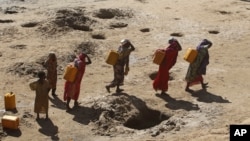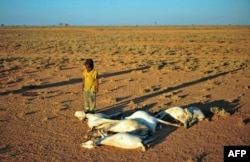United Nations aid agencies warn they have a two-month window of opportunity in drought-stricken Somalia in which to scale-up emergency assistance for millions of people and avert a catastrophe.
The United Nations estimates that half of Somalia’s population, or 6.2 million people, are threatened by the drought, which is spreading from the hard-hit northern regions.
Over the past week, representatives from the World Food Program and the U.N. Children’s Fund, visited some of the worst affected areas in the northern Puntland region.
They describe scenes of utter devastation, where people have reached the limit of their abilities to cope. In one village, the team found about 500 women and children living in precarious conditions in makeshift huts with little inside and surrounded by dead livestock.
“Although these are pastoralists,” said Laurent Bukera, WFP country director, "they had for the whole village one goat and one camel that did not look in good shape."
“That is an area where normally pastoralists have hundreds of sheep and large swaths of camels.”
He said the men had left the village, moving around in search of grazing land and water for the cattle that were still alive.
Short window of opportunity
Speaking on a telephone line from Nairobi, Bukera told VOA that there was a short window of opportunity for aid agencies to scale up emergency operations and prevent the worst from happening.
"The severity, the spread of the drought and of the situation this time around is bigger, is larger geographically than what happened in 2010-11."
“Therefore, if we do not respond fast enough, if we do not respond at scale,” he said, “we can prepare ourselves for a catastrophe, which is at least to the size and the intensity of the situation we experienced over there in 2010-11.”
Nearly 260,000 people, half of them children under five, died during the famine in Somalia between 2010 and 2012. UNICEF projects the number of severely malnourished children in Somalia could reach 270,000 over the coming months.
UNICEF warned that children are among the worst affected by the current drought and that many, once again, are at great risk of dying from malnutrition-related causes.
The agency noted that 944,000 children would likely become acutely malnourished this year, including 185,000 severely malnourished.
UNICEF spokesman Christophe Boulierac said “these children will need urgent lifesaving support. It is very likely that the number of children severely malnourished will increase 50 percent to 270,000.”
He said that by April, 4.5 million people will need water, sanitation and hygiene assistance and that “four million people will be without health services due to the planned closure of health centers due to a funding shortfall.”
$450 million needed
UNICEF and WFP said they required more than $450 million to provide urgent assistance in the coming months.
The needs are expected to grow as the drought in Somalia is set to worsen.
The Greater Horn of Africa Climate Outlook Forum has predicted below average rainfall between March and May, which is the main cropping season for many parts of the Greater Horn of Africa.
Claire Nullis, spokeswoman for the World Meteorological Organization said this was alarming because “it follows two consecutive poor rainfall seasons in 2016 and the likelihood of depressed rainfall persisting into the March to May 2017 rainfall season remains high.”
WFP’s Bukera said aid agencies probably have a couple of months in which to scale up their emergency response to the drought and to take measures to prevent food prices from soaring.
”I think it is extremely critical for us to not only provide assistance to the most vulnerable immediately, but it is also absolutely critical that we make sure that we do not let the market go significantly high as that will be a trigger for an additional catastrophe.”
Though the situation was extremely grave, he told VOA that Somalia had a better chance of averting a catastrophe this time around because the international community had been alerted to this crisis well in advance.
“2011 was a reaction in the summer. It was not an action based on early warning,” he said. “We have today a number of early warnings that let us respond all last year” and was making it possible for us to scale up operations this year.
“So, I think this is a huge difference.”







